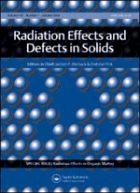|
Literature / Source Database:
Radiation Effects and Defects in Solids
| Title (short) |
Radiat. Eff. Defects Solids |
| CODEN |
RAEFB |
| Languages |
English |
| First year |
1989 |
| Impact factor |
0.472 |
| Editor |
D. Fink |
|
|

|
Status
active
Indexing
INSPEC; Chemical Abstracts Service; ISI Current Contents: Physical, Chemical & Earth Sciences; Cambridge Scientific Abstracts; New Jour; Astrophysics Data System; SciBase and SCOPUS.
Subject

Source type
Journal
Publisher
ISBN ISSN
1042-0150
E ISSN
1029-4953
First volume
108
Last volume
163+
Homepage
| Resources |
|
Availability |
|
|
|
|
|
| Text PDF |
 |
free access |
 |
| Text Html |
 |
for subscriber |
 |
| References |
 |
not available |
 |
| Abstracts |
 |
|
|
| TOC |
 |
|
|
|
|
|
|

Description
Radiation Effects and Defects in Solids publishes experimental and theoretical papers of both a fundamental and applied nature that contribute to the understanding of phenomena or defects induced by the interaction of all types of radiation with condensed matter.
The range of contributions encompasses: radiation physics; radiochemistry; radiobiology and physical effects of medical irradiation, including research on radiative cell degeneration; optical, electrical and mechanical effects of radiation; and their secondary effects such as diffusion and particle emission from surfaces. Topics covered include atomic and electronic properties of defects induced by radiation; the influence of such defects on lattice properties and processes; the lattice-defect approach to solid state reactions such as clustering, precipitation, laser annealing and the role of impurities; the defect dynamics in a non-steady state such as under-particle or electromagnetic irradiation, or during a non-induced rapid temperature change; and problems associated with the metastable nature of amorphous materials. Materials studied may include: semiconductors; polymers and other organic materials; biomatter; and inorganic compounds such as metal oxides, high Tc superconductors and minerals. Submissions discussing biomaterials and nanomaterials are particularly encouraged. Papers dealing with radiation effects on metals will be considered but purely metallurgical papers are not appropriate. Papers dealing with radiation effects in R&D applications are also encouraged, for example: accelerator technology; electronics and opto-electronics; sensors; dosimetry and medical technologies; fusion and fission devices and space research.
All research articles published in Radiation Effects and Defects in Solids have undergone rigorous peer review, based on initial screening by the Editor and refereeing by two anonymous referees. Taylor & Francis makes every effort to ensure the accuracy of all the information (the "Content") contained in its publications. However, Taylor & Francis and its agents and licensors make no representations or warranties whatsoever as to the accuracy, completeness or suitability for any purpose of the Content and disclaim all such representations and warranties whether express or implied to the maximum extent permitted by law. Any views expressed in this publication are the views of the authors and are not the views of Taylor & Francis.
|